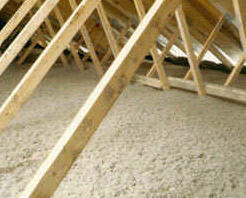Ceiling Attic Insulation
 Overview
Overview
See The Structure
When and Where to Insulate
Retrofit
It is hard to imagine a house today having no attic insulation. If that is the case, the likely culprit is access. The most difficult part of a retrofit attic insulation job is ACCESS. If an attic has no access, generally one can be made in an acceptable manor, such as cutting one in the end of the house and installing a gable end vent in the opening. Other times to insulate include when a new roof is installed or other interior renovations are completed that would allow an opening to be made.
Due to the ‘diminishing returns’ aspect of insulation (the higher the R-value goes, the less savings there is per-R added), an attic with at least 6″ of insulation – or a depth to at least 2″ over the top of the ceiling joists, is considered to be adequate. Adding another 6″ would be good, but does not save as much as the first 6″ does.
If the ceiling joists are exposed, then more insulation should be added.
New Construction
All new houses are insulated according to local or national building codes. Most codes recommend at least 12″ of insulation, or about R-36.
Blow-in insulation is the most common insulation for flat ceiling attics, and fiberglass batts are used for sloped and cathedral ceilings.
It is also important that all skylight shafts, attic access doors, bulk-heads over kitchens and cabinets, and all upper walls that face attic areas be insulated.
Foam insulation is also becoming a popular insulation for ceiling areas, especially for homes with cathedral ceilings or limited space such as around dormers. The foam is sprayed directly to the underside of the roof deck and the attic is not ventilated.
 Insulation Options
Insulation Options
Retrofit
- Blow-in Cellulose
- Blow-in Fiberglass
- Spray Foam
New Construction
- Blow-in Cellulose
- Blow-in Fiberglass
- Fiberglass batts
- Spray Foam
Ventilation
An often over-looked and misunderstood issue is attic ventilation. It is more important (from a structural integrity standpoint) that an attic be properly ventilated than insulated. Of course, both depend on the other to really function correctly.
Some heat loss will get into even the best insulated attics. If the heat is not ventilated, it builds up on the underside of the roof cause snow melt. Water runs down the roof to the eave, where it typically is not over a heated attic so it is colder, and refreezes causing a build-up of ice. Called ‘Ice-dams’, the ice build-up allows water to back-up under the roof shingles causing leaks. The house can also be damaged from ice weight and falling ice.
Moisture must also be ventilated out, otherwise it can form frost on the underside of the roof deck and rafters/trusses, leading to mold formation and structural degradation.
Building codes state how much ventilation must be provided.
In southern climates, the heat build up in unventilated attics damage roofing and increase the use of air conditioning systems. Using Spray Foam directly on the underside of the roof sheathing and removing vents – to create a closed attic – is gaining popularity in warm, humid climates. See Spray Foam for more information.
For more details see Attic Ventilation
Safety Issues

When installing insulation in an existing attic, care must be taken to not cover old wiring – mainly ‘knob and tube’ or wiring observed to be in poor condition, certain kinds of light fixtures, and other heat producing objects such as chimneys and flues.
New wiring and fixtures designed and labeled as such, can be covered with insulation.
Consult local codes for specific information on clearance requirements.
More Information
Open a PDF file from DOE on Attic Insulation and Ventilation
See also www.buildingscience.com
Web sites and sources of information used on this page
Cellulose
Applegate Insulation at www.applegateinsulation.com
Fiberglass
Attic fiberglass Owens Corning at www.owenscorning.com
Reflective
For hot climate applications see Reflective Insulation and Spray Foam
Additional Manufacturers Links:
Cellulose – www.nuwool.com
Fiberglass – www.guardianbd.com
Source: Text Bob Fegan 12/2008; attic fiberglass from Owens Corning web site 8/2003; cellulose information from Applegate Insulation web site 8/2003;
© 2008 Energy Solutions Center400 N. Capitol Street NWWashington, DC 20001 All rights reserved. Legal Contact our webmaster
